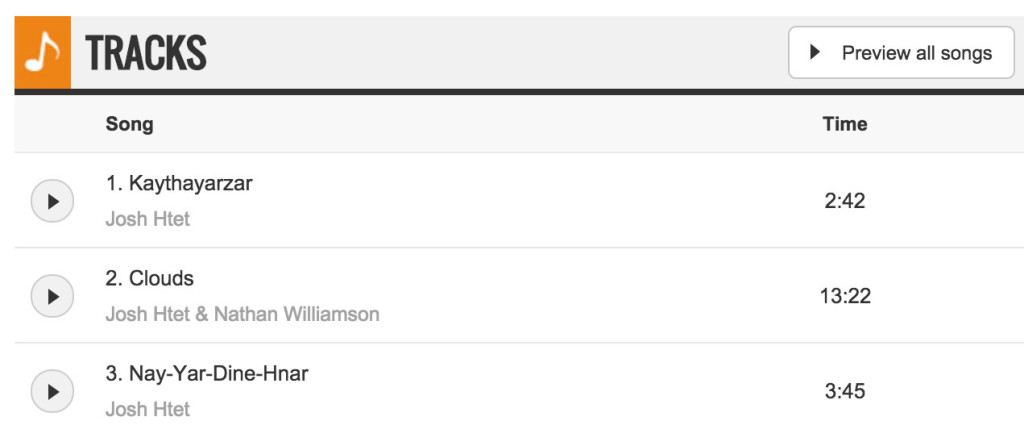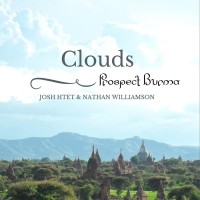I recently had the pleasure of hearing an unusual three-song mordern EP of Burmese folk music, called “Clouds”. It was performed and recorded by Joshua Htet, whose concert “Musical Bridge” we featured previously in Open Your Ears: Musical Bridge to Burma. The two musicians responsible for the recording kindly agreed to join us for an interview and share a bit about the making of this remarkable EP.
Listening to Clouds
When I wrote the previous article mentioned above, Burmese music was entirely new to me and I found it a fascinatingly varied tradition. This new 3-track EP Clouds brings a slightly more modern flavour to those traditions and is more easily accessible to Western ears than some of the traditional Burmese folk music I’d encountered before.

The first track Kay-tha-yar-zar opens with a driving rhythm strummed on guitar before the entry of yearning vocals with an atmospheric reverb applied. The singer (Josh Htet) uses frequent delicate ornamentations around the simple melody. Overall the sound sounds familiar and diatonic to Western ears, but the occasional unexpected accidental along with the lilting ornaments give it a more Celtic or exotic feel.
The title track Clouds is a 13-minute piece for piano and voice arranged in three sections. The first and final sections have soft, lilting vocals with an arpeggiating piano accompaniment gently supporting the voice. Careful variations in tempo convey the singer’s uncertainty and emotion. Between these two sections is a solo piano section, in parts simple and gracefully played, in other parts fuller, firmer and more forceful. It starts from the same vocal melody just heard in the first section but takes it in a very different direction. The arrangement is fairly sparse yet by using minor harmonies and discord it very effectively creates a tense and foreboding mood. This leads into the dramatic middle section, elegantly illustrating the clouds and rainfall of a storm building up and then passing. The final section is a return to the voice and piano combination, soft and somehow comforting after the dramatic middle section.
The final track, Nay-Yar-Dine-Hnar, opens with fingerpicked guitar following a simple progression. The vocal style and melody again have a Celtic flair to them. The song is in a perfect range to suit the singer’s voice, providing a raw emotion to match the rising peak of each chorus. It’s a powerful and distinctive track to end the EP’s journey.
Interview with the Artists

We are joined by vocalist Joshua Htet and pianist Nathan Williamson. Nathan is a pianist and composer who has studied at the Guildhall, Oxford and Yale universities and now maintains a busy schedule of recital performance and commissioning. Josh Htet is an alumnus of the Prospect Burma scholarship programme who lives in London, performing regularly as a singer and guitarist.
J: There were so many modern and traditional folk songs to choose from but these three stood out mainly because I thought they complement each other as a debut EP album. In particular the first and last tracks really worked well supporting the title track Clouds.
N: I was not familiar with Burmese music before working with Josh. The main trick when working with folk music/singers is to get a sense of the words and the way the voice inflects and lifts and falls around the text. Each language has its own very particular stresses, sounds and movement and the musical vocal line will follow that very closely, especially in folk music. This took a bit of getting used to but Josh sings very naturally and clearly so it was easy to follow, and a wonderful discovery!
N: I was invited to give a recital in aid of Prospect Burma, a charity seeking to bring about change in Burma through education, at the beautiful Savile Club a few years ago. I performed with some former students of mine from the Yehudi Menuhin School from different countries – it seemed appropriate to have students of different nationalities involved in the concert.
It was something of a success and the organisers mentioned Josh’s musical ability (he is one of their former scholars and now based in London) and suggested we might collaborate for a future fundraiser. The “Clouds” CD project came out of that, as a memento of our collaboration and also something which could be sold to raise funds for Prospect Burma.
J: Recording the album quickly followed the concert we put together in aid of the Prospect Burma charity last year so we didn’t really need to practise specifically for the album. But for the concert a lot of work went into it from the musicians: Nathan and me as well as the composers and arrangers. We wanted to showcase this curious mix of Western contemporary classical music and the Burmese folk music. And I am proud to say that I think we achieved it.
We recorded with our producer Dom Hammond in a studio in Brixton. Who would have thought a Burmese folk album would come out of Brixton! But there you go, we have London to thank for that.
J: The opening track Kay-tha-yar-zar is a song which was fairly well-known in the 70s and 80s in Burma (or Myanmar). It was performed by a singer called Soe Paing who was very much influenced by old Bengali songs. I rearranged it slightly for guitar and voice.
The opening bars of Kay-tha-yar-zar are unusual for a modern Burmese song, with slightly irregular beats leading to the vocal part. I also wanted to try using different dynamics and unpredictable stops and starts during the song – perhaps fairly unusual concepts for a modern Burmese song. The lyrics are about how a man once full of pride surrendered to his new found love, who then broke his heart – and loses his status as a true lion who never eats grass.
 The title track Clouds conveys the feelings of the singer looking at the dark thick layers of clouds rolling across the sky threatening a heavy downpour, bringing about immense feelings of sadness and longing in him for his long-lost love. The original song was written by an incredibly talented composer called Myo Ma Nyein in the 1950s. There were also elements of Japanese folk music in the song.
The title track Clouds conveys the feelings of the singer looking at the dark thick layers of clouds rolling across the sky threatening a heavy downpour, bringing about immense feelings of sadness and longing in him for his long-lost love. The original song was written by an incredibly talented composer called Myo Ma Nyein in the 1950s. There were also elements of Japanese folk music in the song.
I wanted to see what Western classical interpretations we could come up with on this song. First I commissioned a classical arrangement of the song from a composer friend called Christopher Scobie who gently adapted it for (Western) piano chords and voice – bringing those beautifully sombre original chords to the fore. I also wanted a standalone classical piece for the piano so commissioned another young composer called Hannah Varty (who studied at the then Trinity College of Music in London) and after reading books on Burma and studying the song and Burmese music generally she came up with a wonderful contemporary classical interpretation of the song that takes the listener on a journey beginning with the clouds, followed by thunder and rain drops before ending with solitary chords and a sense of overwhelming loneliness. On the recording this classical interpretation is opened and closed by Chris Scobie’s arrangement of the song. Nathan’s meticulous playing on the piano really brings this track to life!
The last track Everywhere is a simplified arrangement of a song by a Shan singer called Saing Htee Saing. It tells of two people still feeling very close to each other despite all the distances between them. “We are far apart but at least I am seeing the same sun which has just given you warmth”, he comforts her.
This is my wife’s favourite song so it had to be on my debut EP! This song is special to many people in Burma for different reasons. During one of my gigs in London, an exiled daughter of a famous political prisoner thanked me for singing this song, as her father used to sing it to her to remind her that they are never far apart.
J: Burmese music does use both guitar and piano, although the arrangement, interpretations and the way we played the music on this album might be fairly unusual to Burmese listeners.
J: Prospect Burma is an education charity supporting young people of Burma who want to get their higher education abroad and then return to play a part in the rebuilding of the country. It has supported young people of Burma (including me) for the last 25 years, producing doctors, engineers, lawyers and scientists, most of whom have gone back to Burma recently to help with the rebuilding of the country. But given how long the country was cut off from the rest of the world until recently and the state of higher education in those isolated years, the charity still has a lot of work to do in helping Burma realise its potential.
Thank you again, Josh and Nathan, for joining us to share the story of this wonderful EP. Clouds can be purchased online (CD or MP3) from CDBaby or directly on CD from Propspect Burma. All proceeds go to support the work of the Prospect Burma charity.







